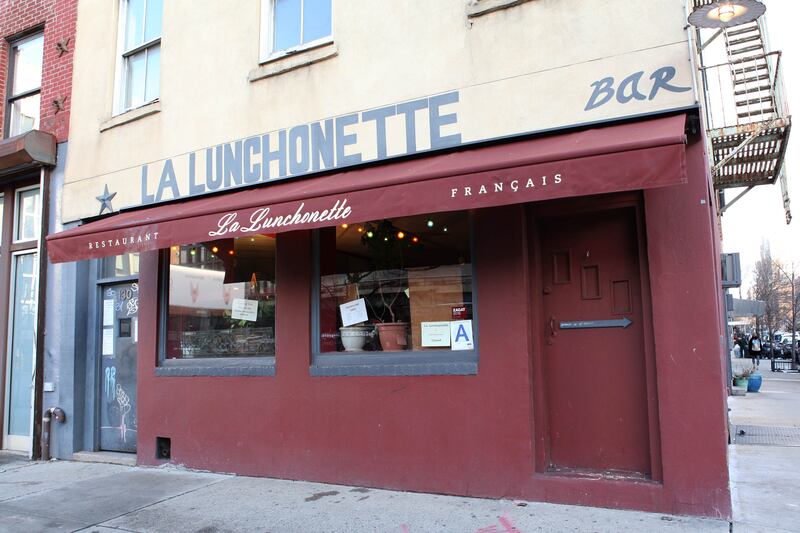On an unusually warm February afternoon in New York City, the door to La Lunchonette hangs open and Jean-François Fraysse is on the telephone.
The Chelsea restaurant, owned by Fraysse and Melva Max—and located at the Northeast corner of 18th Street and 10th Avenue near the Daily Beast’s office—operated from 1988 until December 31st, 2015.
They served their last dinner on New Year’s Eve. One month later, the place is emptying. Almost everything has a price tag, or is for sale.
When a woman walks in off the street and says to Fraysse that the glass and metal frame in the window is something her mother might like, he asks her to name a price. She says she’ll be back.
Many of the items for sale are utilitarian and the prices based on nostalgia more than value. A giant kitchen scale is only $5, the sandwich boards that listed the last specials, $100. A curiously expensive pepper grinder, a forearm-sized monster of a thing, is $40.
“The little ones are fifteen,” Fraysse says.
***
“Something’s not right in our world anymore.” Max, co-owner of La Lunchonette and spouse to Fraysse, says.
When Fraysse first leased the place, the restaurant’s name was already written on the side of the building. He added “La” in front to make it feel more French.
“I almost didn’t hire her,” Fraysse says. “It was a woman who worked as a waitress who said, ‘Why don’t you take another look? Later, we were married.”
The accomplished restaurateur holds a postcard as he says it. It shows a picture of the couple in 1988, when La Lunchonette opened.

At the time, Max was already an experienced restaurant manager who previously worked at more upscale eateries.
Built in 1910, 130 10th Ave, where La Lunchonette has lived these past thirty years, is a Chelsea landmark.
Its image is captured in diverse art from the P.L. Speer archives to the opening credits of the web series Downtown Girls. On one episode of Law and Order the place was transformed into a Chinese restaurant, another made it over as an African eatery. It can also be seen in recent episodes of The Black List.
“So many people have been coming in saying ‘I can’t believe it.’” Max said. “People had their graduation parties here, Valentine’s dinners.”
“The people you would see here.” Fraysse says. “Basquiat (as in the artist Jean-Michel Basquiat). But that was the 1980s.”
When La Lunchonette finishes clearing out, 130 10th Avenue, the pre-Civil War building next to it, and three adjacent others will be torn down to build ten story luxury apartments.
Max also sees a bizarre coincidence in the building’s future. “La Lunchonette has been a favorite of top architects.” She said. “Steve Hall had his birthday dinner here. Gilles Nordensen. A lot of architects and designers loved the restaurant.”
Max acknowledges that “Change is inevitable,” but—she says incredulously—“for something so pretentious like a wooden building that is basically condos for four or five people?”
At the opposite end of the next block, the corner of 19th Street and 10th Avenue is nearing the end of a similar transformation. Construction crews are finishing the inside of another giant apartment building on the site of a former building materials warehouse. There are three more gargantuan structures at the end of the block, all less than ten years old.
Designed by SHoP architects, whom Curbed called “NYC’s go-to megaproject architects,” the new building will feature a wooden frame for which the Department of Agriculture, the Softwood Lumber Board, and the Binational Softwood Lumber Council have awarded a $1.5 million subsidy.
“This is where our tax dollars are going.” Max said. “And did you hear about the little building? Jeremiah wrote about it.”
Jeremiah is Jeremiah Moss of the blog Jeremiah’s Vanishing New York, who the Daily Beast profiled in 2014.
Like an obituary page for places instead of people, Moss’s online chronicle of New York City’s endless departures has kept a close eye on La Lunchonette’s closing, from the initial rumors in the fall of 2014 that the building’s owner was fielding offers too tempting to resist, to the artefact sale that began this story.
“The texture of New York is really being worn down.” Max said. “That’s why people loved La Lunchonette, it had character. There were rough edges. It was real. The best part was the food on your plate. You come in, you’re going to have a delicious dish. There’s no tra-la-la, no artifice. Just a decent meal.”

Moss places particular blame for La Lunchonette’s closing on what he calls “The High Line Effect,” or hypergentrification in which the previous generation of gentrifiers are themselves gentrified out.
The reclaimed elevated train tracks along the Hudson River have been the death of countless small business as more tourists pour into the formerly neglected neighborhood.
“This is why I love Jeremiah. He was talking about these stories long before it happened to us. He’s doing some great things,” Max said. When Moss first wrote about La Lunchonette’s impending closure, Max told him “The High Line has been the cause of my demise.”
The lease that La Lunchonette was operating under at the time of its closure gave the landlord the option to evict his tenants with six months’ notice and included substantial (yearly) rent increases, which caused the establishment to raise their prices—but only slightly.
“I can’t charge $60 for beef bourguignon, and I wouldn’t.” Max said. “I’ll be damned if he’s going to push me out before my time but we had to raise prices at the end or we would have had to close earlier.
“We didn’t cut corners to save money or reduce pay. We had to keep the quality up. We wanted to go out with grace, dignity, integrity, and making people happy. That’s it. There’s not much integrity left in New York when chains get breaks and small businesses struggle.”
When Fraysse opened La Lunchonette in 1988, there were four shootings nearby, three right outside the restaurant. Now there is an Apple Store around the corner in a building that opened the same year as the original Yankee Stadium. The city tore down that Bronx baseball palace in 2010. Perhaps it too might have been spared had anyone put an Apple store in it.
All this destruction is taking place at a time when New York City’s Landmarks Preservation Commission is also redefining how it designates buildings as landmarks. The current process is so onerous some ancient properties spend decades in limbo. Applications to the Commission oftentimes outlast the commissioners.

Even without the lengthy Landmark application process, and even though it is 100 years old, it appears unlikely that 130 10th Avenue might become an actual, capital-L, New York City Landmark.
Not is it so easy to dismantle the historic structure. First La Lunchonette’s tile floor must be ripped up, then the tile floor underneath that, to get to a third layer which contains hazardous asbestos.
“The landlord had it removed from the roof a few years ago.” Fraysse says.
An art gallery had lived in the space next door in a building that will also be torn down to make way for the wooden high rise. For most of the last year it has been closed. A sign taped to the front door proclaims the place asbestos free… and ready for demolition.
Anachronistic flame-retardants notwithstanding, the location is also at risk of flooding.
The natural island of Manhattan ends across the street from La Lunchonette, everything from the High Line down to the water is landfill. In the wake of Super Storm Sandy the area experienced such heavy flooding that businesses were closed for weeks. Nearly four years later, promised flood protection infrastructure has been slow to materialize.
What Moss calls the “Disneyfication” of the area around the High Line, and the New York Times referred to as “family-friendly,” is a euphemism that conceals the real damage done to families in the area. Hypergentrification may be detrimental to businesses, but it is lethal to families.
Until the coming of the high rises, the Robert Fulton Homes, located down the block from La Lunchonette, were the uncontested tallest building in the neighborhood.

Residents have feared for years that expensive development might push them out in the long term, but in the short term everything is getting more expensive.
While a housing boom means more available units, few are affordable to long-term residents. The recently completed apartments across 10th Avenue are selling in the millions and the number of restaurants in the neighborhood that offer a decent meal at an affordable price shrinking.
“The whole thing is so strange.” Max said. “To me it’s just, how could money like that be used to destroy these old buildings that should have been landmarked? This was a place where middle class New Yorkers could come and have a little taste of France.”
Nearby Gotham Pizza on 9th Avenue still sells slices for a few bucks apiece, but one block away from La Lunchonette a whole pie at Artichoke Basille costs upwards of thirty dollars. [Note: In their defense, the Artichoke pie is delicious.]
***
With La Lunchonette closed Max may find another job managing, but in the meantime she teaches yoga. Fraysse says he plans to stay busy with work for a French non-profit.
There are no plans to open another restaurant, and even if there were the area is now too expensive and volatile for them to do it in Chelsea.
Despite the unpleasant end, Max spoke highly of her time at the restaurant. “There were memorable moments every day. The customers are fantastic. People really got it. They understood what we were about.”
Items from La Lunchonette will be on sale through this weekend.






